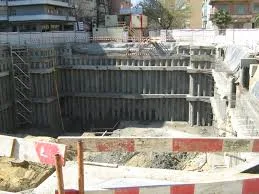Definition:A deep excavation is an excavation that extends significantly below the original ground surface. The design and execution of such excavations require careful consideration of various factors to ensure safety and stability.
Click the Translate button(see right) on this post to set your Own Language to understand more perfectly!!
Deep Excavation Calculator
DefinitionContinue: Deep Excavation
A deep excavation is an excavation that extends significantly below the original ground surface. The design and execution of such excavations require careful consideration of various factors to ensure safety and stability.
Key Parameters:
Excavation Depth (m): The vertical distance between the original ground surface and the bottom of the excavation.
Excavation Width (m): The horizontal distance across the excavation.
Support System Type: The type of structure used to retain the excavated soil and prevent collapse. Common types include sheet piles, secant piles, and diaphragm walls.
Support System Thickness (m): The thickness of the support system elements.
Sample Values:
Excavation Depth: 15 meters
Excavation Width: 10 meters
Support System Type: Diaphragm wall
Support System Thickness: 0.6 meters
Example Calculation:
While there's no direct calculation for determining the optimal parameters for a deep excavation, these values can be used as a starting point for further analysis. The selection of excavation depth, width, and support system is influenced by factors such as:
Soil conditions: The type and strength of the soil will determine the required depth and support system.
Groundwater conditions: The presence of groundwater will impact the excavation stability and dewatering requirements.
Surrounding structures: The proximity of buildings and other structures will affect the excavation design.
Construction methods: The chosen excavation method (e.g., top-down, bottom-up) will influence the support system requirements.
Additional Considerations:
Soil investigation: A thorough geotechnical investigation is essential to understand soil properties and groundwater conditions.
Structural analysis: The support system must be designed to withstand the lateral earth pressures and other loads.
Monitoring: Instrumentation should be used to monitor ground movements and excavation stability during construction.
Safety measures: Appropriate safety measures must be implemented to protect workers and the public.
Note: Deep excavation design is a complex process requiring expertise in geotechnical engineering, structural engineering, and construction methods. The provided example is a simplified overview and should not be used for actual design without considering specific project conditions and applicable codes and standards.
Let's Delve Deeper: Support System Design for Deep Excavations
Understanding Support Systems
Support systems are crucial for the stability of deep excavations. Common types include:
Sheet Piles: Interlocking steel or concrete sheets driven into the ground.
Diaphragm Walls: Concrete walls constructed in-situ using a trenching process.
Secant Piles: Overlapping concrete piles formed by excavating and filling with concrete in stages.
Soldier Piles and Lagging: Steel piles with horizontal timber or steel planks for temporary support.
Design Considerations:
Soil Properties: Soil type, unit weight, cohesion, and angle of internal friction are essential for determining lateral earth pressures.
Groundwater Conditions: Water table level and permeability influence hydrostatic and hydrodynamic pressures.
Excavation Depth and Width: These dimensions determine the overall size of the support system.
Surrounding Structures: Proximity of buildings and other structures affects the allowable deformations and vibrations.
Construction Sequence: The order of excavation and installation of support elements impacts the design.
Calculation Example: Lateral Earth Pressure
A common method to estimate lateral earth pressure on a retaining wall is using Rankine's theory.
Active Earth Pressure:
Pa = Ka * γ * z^2
Where:
Pa = active earth pressure
Ka = active earth pressure coefficient
γ = soil unit weight
z = depth below ground surface
Passive Earth Pressure:
Pp = Kp * γ * z^2
Where:
Pp = passive earth pressure
Kp = passive earth pressure coefficient
Note: These are simplified equations, and actual design considers factors like soil cohesion, surcharge, and wall friction.
Support System Design
The support system must resist the lateral earth pressures and other loads. Structural analysis is required to determine the required thickness, spacing, and reinforcement of the support elements.
Additional Considerations:
Deflection and Movement: The support system should be designed to accommodate expected movements and deformations.
Waterproofing: If groundwater is present, waterproofing measures may be necessary to prevent water ingress.
Construction Sequencing: The installation of the support system should be coordinated with the excavation process.
Monitoring: Instrumentation is essential to monitor the behavior of the excavation and support system during construction.
By carefully considering these factors and utilizing appropriate design methods, engineers can ensure the safety and stability of deep excavations.
:How To Earn From The Deep Excavation Calculation in our real life application????
Monetizing Deep Excavation Knowledge
Understanding deep excavation principles is crucial in various industries. Here's how this knowledge can be monetized:
Consulting Services
Geotechnical Engineering: Offer expertise in soil investigation, ground water analysis, and slope stability assessment for deep excavations.
Excavation Design: Design and optimize deep excavation projects, considering factors like support systems, dewatering, and ground improvement.
Construction Supervision: Oversee deep excavation projects to ensure compliance with design and safety standards.
Risk Assessment: Evaluate potential hazards and develop mitigation plans for deep excavations.
Software Development
Excavation Simulation Software: Develop software to simulate excavation processes and predict ground behavior.
Support System Design Software: Create software for designing and optimizing support systems.
Education and Training
Workshops and Seminars: Conduct training programs on deep excavation techniques, safety, and regulations.
Online Courses: Develop online courses on geotechnical engineering and excavation methods.
Other Avenues
Expert Witness: Provide expert testimony in legal cases involving excavation-related disputes.
Research and Development: Contribute to research on new excavation technologies and methods.
Key to Success:
Deep understanding of geotechnical engineering principles and excavation methods.
Proficiency in using geotechnical software and analysis tools.
Strong communication and interpersonal skills to collaborate with clients and teams.
Networking with engineers, contractors, and government officials.
By effectively applying your knowledge of deep excavation, you can create value for construction projects and generate income through various avenues.
Do YOU Want To Earn Money In Various Ways, Click The Link & Explore Your Field of Interest!!!









No comments:
Post a Comment